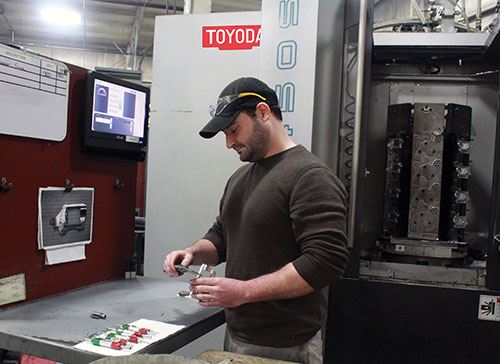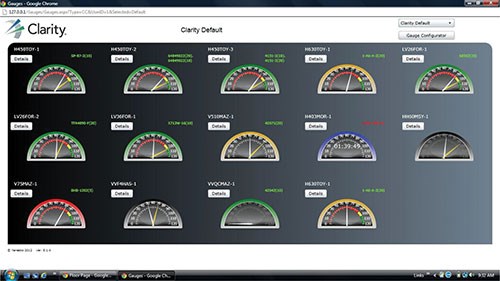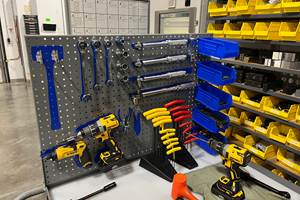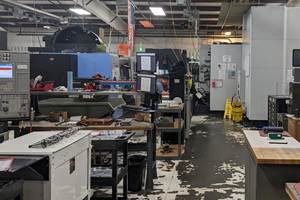Live-Monitoring Software Maximizes Automation Investment
By implementing its own shop management software, Lynar Corporation was able to increase productivity by 15 percent.
Finding ways to increase production is a never-ending pursuit for machine shops like Allentown, Pennsylvania-based Lynar Corporation. After adopting the latest cutting tools and setup techniques, the shop invested in two Toyoda automation cells. While this increased overall spindle utilization, it became apparent that the company needed a better way to track, monitor and motivate production across all shifts. After considering a variety of different live-monitoring software packages, the company decided to develop its own.
Lynar Corporation, a CNC milling and turning shop that specializes in castings, is housed in a 28,000-square-foot facility. As part of its ongoing efforts to increase production capability, the shop purchased two Toyoda HMC automation cells: a four-spindle, 22-pallet, 450-mm-sized flexible manufacturing system (FMS) and a two-spindle, 15-pallet, 630-mm-sized FMS. The cells increased overall spindle utilization by 85 percent during the company’s 24 hours a day, five days a week production.
Increased production became a double-edged sword for Lynar as it became increasingly difficult to monitor it across all shifts. The number of actual parts produced versus the number of quoted parts varied largely by shift, says Kevin Lesko, who co-owns the company with his brother Chad and their father. The company needed a way to measure output consistency between shifts and enable management to view production in real-time. According to Lynar, when it began searching for live-monitoring software in 2008, all of the real-time management software packages lacked a crucial element: They only monitored CNC uptime, not whether the operator was keeping the machine in cycle to a known standard.
With no software available to meet Lynar’s exact needs, Kevin and Chad began working on their own live-monitoring software. Two and a half years later, they developed Clarity web-based productivity management software to provide real-time tracking and feedback of operator performance, production targets and cycle time verification on all CNC machines and factory equipment. The highly visual display enables anyone to interpret data at a glance.
Clarity ties into a shop’s ERP system to see a part’s work order, number, cycle time and the inefficiency allowance associated with it for a given machine. Every part number’s pieces-per-hour is defined as 100 percent, regardless of machine utilization. “Shops don’t quote by machine tool utilization. We quote by how many parts are on the skid by the end of the day,” Chad Lesko explains. When Clarity displays 100 percent at the machine tool, operators know they are producing what management has quoted.
Production monitoring begins when the operator clocks in at the touchscreen computer attached to the machine. The software extrapolates productivity from the first few runs and displays the data in gages on both the operator’s computer and the supervisor’s dashboard. If a gage is falling short midway through a shift, operators have the ability to make up for lost time. This enables them to correct production issues as they are happening rather than waiting until the previous day’s reports are available to find out they didn’t make the expected quantity. “Production reports no longer have a low number on them without supervisors already knowing what happened,” Mr. Lesko
says.
Operators can use their panels to select one of 40 user-defined reason codes to identify why production has stopped. These reason codes can include factors that typically slow production, such as running out of material, low coolant levels, tool failure and machine alarms. When selected, a timer is displayed on both the operator’s panel and management’s dashboard until the code is resolved. Quantifying why production has slowed enables Lynar to define top reason codes and the downtime associated with each one. If the target isn’t met, management can see that the problem was independent of the operator and more attention can be focused on the true issue at hand.
The reason codes also provide better communication throughout the shop. They can be tied into an automatic messaging system that triggers text messages and emails to alert others when assistance is needed. For example, Clarity can send text messages directly to forklift drivers when a machine needs more material. After a user-determined timeframe, supervisors can choose to be alerted via email or text if the reason code has not been resolved. The operator’s pace depends on availability of material, the number of measurements in a cycle, tool wear and other factors. “The operator is the single greatest influence on whether the machine makes the expected parts on the skid that day,” Mr. Lesko says. “It’s all about the operator keeping that machine in cycle and cutting chips.”
To help oversee the entire production process, supervisors can view all machines in a cell or plant from a single dashboard display on their computer. The machines are represented by individual gages on the supervisor’s dashboard. These gages range from 0 to 120 percent to give a quick view of how actual production on each machine compares to the shop’s pre-determined targets. For a more in-depth overview of production, supervisors can use customizable Crystal Reports, which enable them to see if they are on pace to meet, exceed or fall short of their targets. Productivity reports can also be pulled by machine, shift and operator to isolate these factors and determine if a job will run better on a particular machine or by a particular operator.
When Lynar first implemented Clarity, these reports exposed a few unexpected figures to Mr. Lesko. For instance, within 24 hours, he learned that several jobs were producing a variety of different quantities across multiple shifts. Feed-rate overrides and modified programs had altered workpiece cycle times, but the price per workpiece did not reflect these changes. Now, Mr. Lesko receives a report whenever a cycle time is 5 percent more or less than the predetermined standard. “I can actually tell if it’s operator-dependent by how many pieces we make per day or if it’s the job itself,” he says. The shop can now adjust the customer’s price as the output per shift changes.
Another benefit of the software is that the real-time reporting enables operators to know when they are doing their jobs successfully. The gage shows daily operator productivity, which they can try to beat. Management can also see which operators are performing exceedingly well with a specific workpiece on a particular machine. Armed with this knowledge, they can recognize operators who are doing their jobs particularly well. Mr. Lesko recognizes that talent and motivation can make a difference in a shop.
“It’s now very easy to compare one person to another and have a solid number for incentivizing your shop,” he says. Since implementing Clarity, which the company is now selling to other shops in a new venture, Lynar has seen a 15 percent increase in productivity. “From what we see, the more operator involvement with a process, the more productivity is typically gained,” Mr. Lesko says.
Related Content
Translating a Prototyping Mindset to Production
The experimental mindset that benefited BDE Manufacturing Technologies as a prototype job shop has given it an adaptable edge as a production facility.
Read MoreShop Replaces Two Verticals With One Horizontal
By trading two VMCs in to help finance the purchase of a new HMC, this shop was able to significantly increase production and move to lights-out machining.
Read MoreVolumetric Accuracy Is Key to Machining James Webb Telescope
To meet the extreme tolerance of the telescope’s beryllium mirrors, the manufacturer had to rely on stable horizontal machining centers with a high degree of consistency volumetric accuracy.
Read MoreThe Debut of an HMC Series
The FH5000 Series from JTEKT Toyoda is compromised of three high-speed horizontal machining centers.
Read MoreRead Next
The Cut Scene: The Finer Details of Large-Format Machining
Small details and features can have an outsized impact on large parts, such as Barbco’s collapsible utility drill head.
Read More3 Mistakes That Cause CNC Programs to Fail
Despite enhancements to manufacturing technology, there are still issues today that can cause programs to fail. These failures can cause lost time, scrapped parts, damaged machines and even injured operators.
Read More.jpg;maxWidth=970;quality=90)










.jpg;maxWidth=300;quality=90)

.png;maxWidth=300;quality=90)










.png;maxWidth=300;quality=90)









.jpg;maxWidth=970;quality=90)